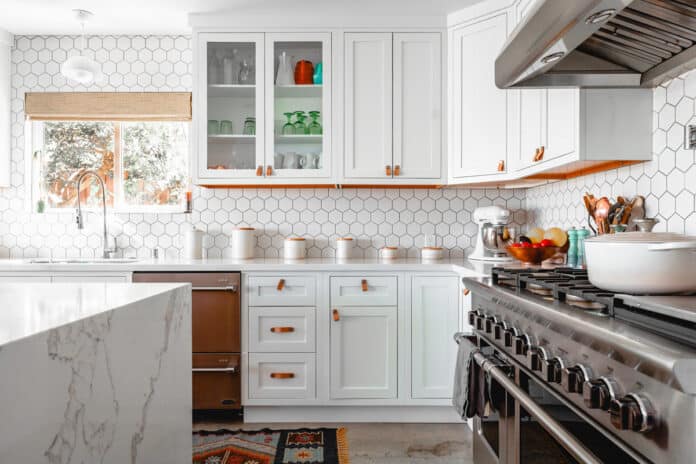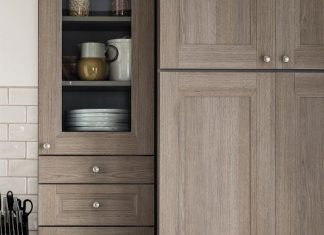If you are in the market for new custom-made cabinets for your home, one term you will encounter is RTA. This is the abbreviated form of ready-to-assemble. It means that if you order RTA kitchen cabinets, you must assemble them before installing them.
The key benefit of ordering this type of cabinet for your home is the substantial price savings compared to brand-name and/or custom-made preassembled cabinets without sacrificing quality.
With a few exceptions, your order includes all the parts needed to assemble RTA kitchen cabinets. However, you need your own tools to assemble the cabinet, as these are not part of your cabinet order.
Additionally, not included are any door handles and wall mounting screws. These items must be purchased separately. In fact, this is common whether you purchase RTA cabinets or preassembled ones from a local retailer.
Pros of RTA Cabinets

- Shorter Lead Time: Typically, RTA cabinets arrive at your door sooner than their preassembled counterparts, allowing you to kickstart your renovation project without long delays.
- Easy to Customize: RTA cabinets offer nearly endless options for material, finish, and size, making it easy to tailor them to fit your specific design vision.
- High-Quality Materials: Despite their ready-to-assemble nature, these cabinets often come in high-quality materials, including solid wood, ensuring durability and a premium look.
Cons of RTA Cabinets
- DIY Install: While an appealing project for the DIY enthusiast, remember that you will typically be responsible for the installation. Hiring a professional is an option but will increase costs.
- Time Commitment: Installation is not an overnight task. Be prepared to invest time and effort to assemble your kitchen.
- Warranty Limitations: Since professionals do not perform installation, manufacturers may not offer warranties, which could be a drawback for some buyers.
By understanding the advantages and potential drawbacks, you can decide whether RTA cabinets are the right choice for your kitchen renovation.
Pro Tips To Ensure Quality RTA Cabinets

When shopping for ready-to-assemble (RTA) cabinets, focus on durability and beauty. Here’s a guide to identifying quality options:
Drawer Construction
- Material: Opt for drawers crafted from solid wood rather than inferior materials.
- Joinery: Look for dovetail joints that offer superior strength to simple staples or glue.
Drawer Guides
- Extension: Choose full-extension drawer guides for complete access and usability. Avoid those with integrated rail systems, as they often lack smooth operation.
Door Specifications
- Frame and Panels: Doors should feature a solid wood frame. The panels themselves should ideally be solid wood or high-grade plywood to ensure longevity.
- Avoid Inferior Materials: Steer clear of veneered particleboard or medium-density fiberboard (MDF) for door construction, as they can compromise the cabinet’s durability.
Finishes
- Application Method: Prioritize finishes applied by brush, as this method tends to result in a more durable and even coating than those sprayed on.
If you’re purchasing in person, inspect these elements closely. When shopping online, consider requesting a sample door to examine quality firsthand. This proactive step helps ensure you receive cabinetry that meets your expectations and stands the test of time.
Are RTA Cabinets Worth The Investment

So, are RTA cabinets worth buying? Definitely.
It is worth the extra work to put together RTA cabinets because of the cost savings. Compare the costs to remodel a basic-size kitchen with high-quality solid wood cabinets. Cabinets from local retailers can easily cost $10,000 or more just for the convenience of arriving preassembled.
Similar unassembled cabinets only cost around $2,500. Why pay this much in labor to save a little time and work when it is not difficult to put the cabinets together?
But it’s not just about saving money. RTA cabinets also offer impressive durability, making them a smart investment for the long run. These cabinets are crafted with high-quality materials to withstand the wear and tear of daily kitchen activities for decades.
Conclusion
When you’re aiming for a quick renovation on a budget, RTA cabinets provide the perfect solution without compromising on quality. By choosing RTA cabinets, you benefit from both affordability and longevity, ensuring your kitchen remains stylish and functional for years.
For more details on assembling RTA cabinets, visit our website and review our video and step-by-step photo assembly instructions. RTA cabinets are designed for easy assembly using wood dowels, screws, and glue, allowing you to put them together efficiently.
Comprehensive instructions are available in written and video formats to assist the process, cater to different learning preferences, and ensure a smooth assembly experience.
Whether you’re a DIY enthusiast or new to cabinet assembly, our resources provide the guidance you need to complete your project confidently. With clear and detailed instructions at your fingertips, you can enjoy the satisfaction of assembling your own cabinets.
FAQs
Here are frequently asked questions about RTA cabinets.
Are RTA Cabinets Good Quality?
High-quality RTA cabinets can be just as robust as their traditionally assembled counterparts. Select cabinets made from durable components such as solid wood or high-grade plywood, which are known for their longevity. Additionally, pay attention to the hardware, like hinges and drawer slides—opting for stainless steel or other durable metals will enhance the overall sturdiness.
How Long Do RTA Cabinets Last?
Generally, well-constructed RTA cabinets are designed to last 20 years or longer. However, their lifespan can greatly depend on crucial factors such as quality of construction, installation precision, and maintenance and care.
How Long Does It Take to Assemble RTA Cabinets?
Assembling Ready-to-Assemble (RTA) cabinets can vary in time depending on your experience level and the complexity of the cabinets. If you’re new to the task, each cabinet generally takes 30-45 minutes. You’ll likely become quicker as you become more familiar with the process.









